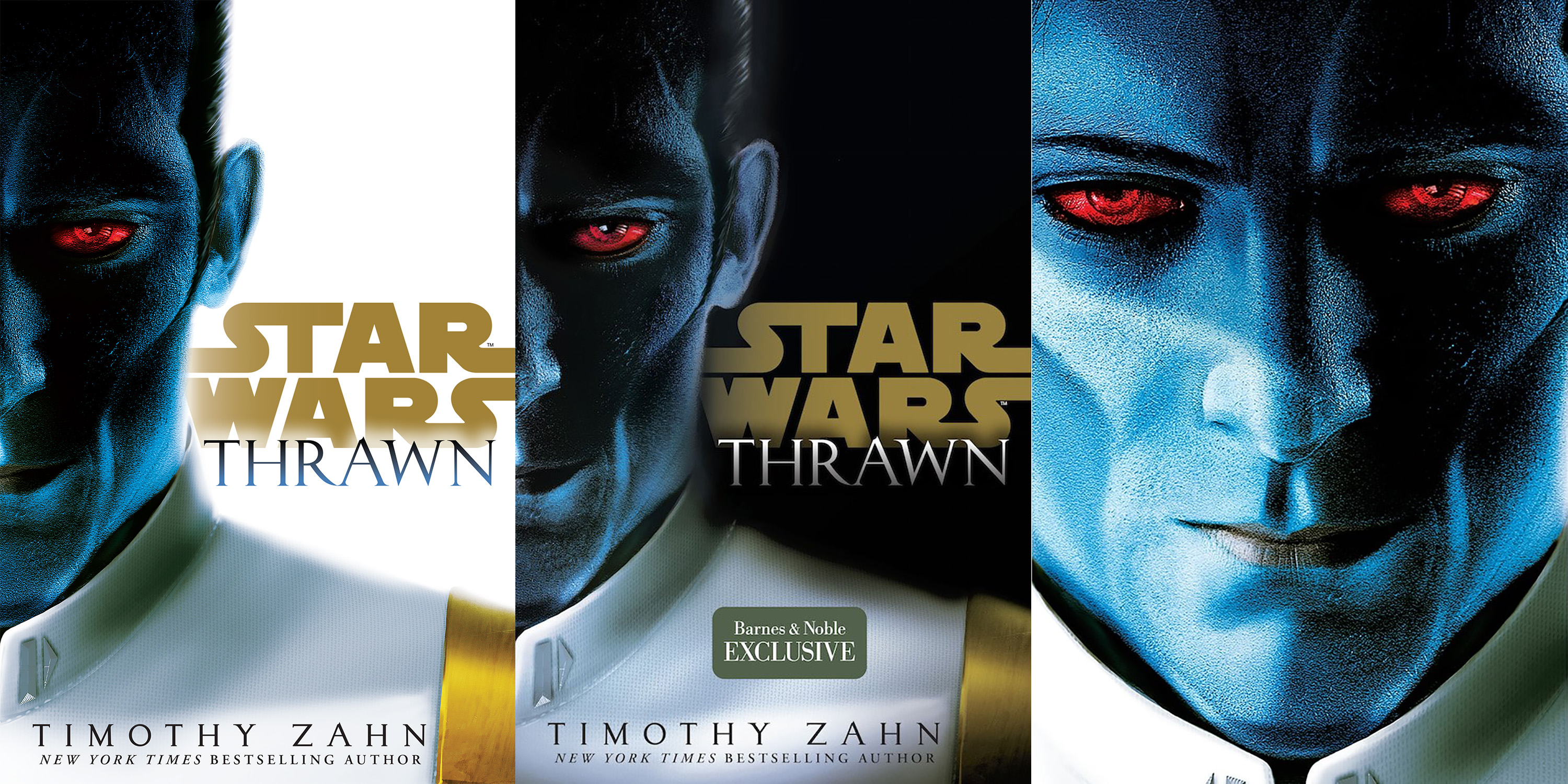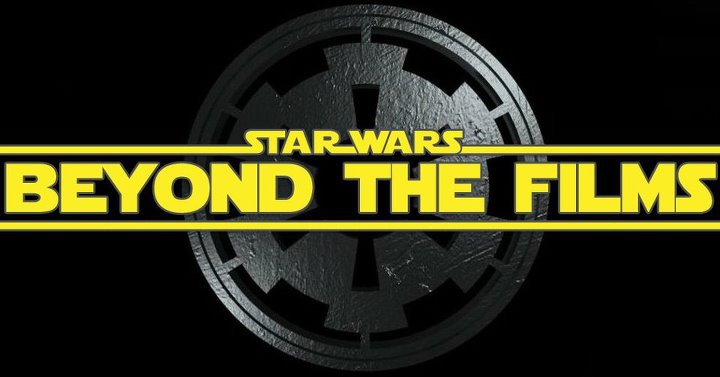Star Wars Beyond the Films‘ Nathan P. Butler is now posting short, non-spoiler reviews for many new releases. Spoiler-filled discussion will often follow in the weeks or months thereafter on the podcast.

Thrawn by Timothy Zahn (hardcover, 2017)
Left to right: regular version, Barnes and Noble exclusive variant, Star Wars Celebration 2017 Variant
In 1991, Timothy Zahn launched the Star Wars Expanded Universe (now known as the Legends continuity) with Heir to the Empire, the first part of the Thrawn Trilogy, set five years after Return of the Jedi. The trilogy’s villain, Thrawn (or Mitth’raw’nuruodo to his people, the Chiss), became one of the most recognized characters in the millennia-spanning saga. Even when he himself was absent from the stage, impostors drove the Hand of Thrawn duology (1997 – 1998) in his name. Stories of his earlier exploits and related tales continued to be produced until the end of Legends novel publishing, as the EU explored the Outbound Flight Project (Survivor’s Quest and Outbound Flight), his involvement in the era just after A New Hope (Choices of One), and more. His background was even expanded on in the unfortunately short-lived Official Star Wars Adventure Journal with tales like Mist Encounter and Command Decision.
When it became clear that Thrawn would be “returning” in Star Wars: Rebels, fan reaction was immediate and divided. Would this canonical Thrawn live up to his alternate universe Legends counterpart? Would Timothy Zahn play any role in recreating the character he created decades earlier? Would this Thrawn fall into the same “damned near omniscient,” unbelievable quasi-godhood of how Zahn portrayed the character and his machinations in later works? Did canon have room for a mind like Thrawn’s when simultaneously trying to build up Gallius Rax in the pages of the Aftermath Trilogy?
With the third season of Rebels concluded, the backstory of the canonical Thrawn now comes to light in the pages Thrawn, written by the character’s creator (who later “ruined” the character in some fans’ eyes), Timothy Zahn.
Thrawn
In the interest of full disclosure, I am one of those fans torn on the Legends version of Thrawn. I dearly loved the Thrawn Trilogy, and it remains one of the few Star Wars novel series that I have re-read repeatedly, including its later comic adaptation. The political intrigue in the Hand of Thrawn duology also drew me in heavily, and I enjoyed seeing tidbits of his early exploits in Mist Encounter and other short stories. However, in later years, it seemed to me that Zahn was often “phoning it in,” trading more on his name as “the great Star Wars EU launcher” than good storytelling. Over time, the Thrawn present in his stories was nearly godlike in his ability to unfailingly predict the actions and reactions (to a ridiculous number of actions removed) of anyone and everyone. He became a master chessman, against whom the only realistic chance of avoiding defeat was simply not to play at all. Rather than brilliant, Thrawn became unbelievably (and I mean that literally) capable of acts and predictions that would make even Palpatine (sans “Sheev,” since he never had that name in Legends) fawn in admiration. It was, in light of my fascination with the Thrawn Trilogy, a death blow to his characterization.
With that in mind, I was wary when it was announced that Thrawn would be joining the Imperial cast of Rebels. I worried that this was more fan service than a chance for strong storytelling, more Choices of One than Heir to the Empire. His first few brief appearances did little to calm those worries, but, thankfully, by the end of the third season of Rebels, I had become a believer: Filoni and company had handled Thrawn well. The question remained, though, as to whether Zahn, who had created this fantastic character and then inexplicably ascended him to godhood, would bring his “A-game” of the 1990s to writing Thrawn or his cringe-worthy New Millennium approach.
Thankfully, it is the former, making Thrawn one of the strongest novels featuring the character (albeit in canonical form this time) in the last twenty years.
The novel begins with a scenario adapted (with tweaks for the needs of canon and this novel, of course) from 1995’s Mist Encounter, serving as our insight into how Mitth’raw’nuruodo joins the Imperial ranks as Thrawn. Accompanied by a new canonical aide, interpreter, and (dare I say it?) friend, Eli Vanto, the novel then follows Thrawn’s ascension through the ranks as he encounters various enemies of the Empire, including the mysterious “Nightswan.”
Along the way, Thrawn is presented here less like a god or a tactician solely drawing from artwork for his insights and more akin to Sherlock Holmes (a bit like a combination of Sir Arthur Conan Doyle’s original character and the more recent Robert Downey Jr. film version). Each chapter opens with a bit of insight from Thrawn in the style of a log or journal, and story segments told from his perspective (still third person limited, not first person) tend to often include insights into what he is noticing about situations and individuals, right down to small changes in physiology. This new, canonical Thrawn has a brilliant mind and is a keen observer, and we get just enough insight into his thought process that his leaps of deduction never feel forced or superhuman (superchiss?). Instead, he remains believable throughout.
As much as this is Thrawn’s story and that of his aide, Eli, one could argue that they only make up about 60% of the novel’s narrative. The rest is, surprisingly, the story of Arihnda Pryce, who by the time of Rebels is Governor of Lothol, though unseen until the series’ third season. Her ascension dovetails neatly with elements of Thrawn’s story, making her appearance alongside him in Rebels significantly more meaningful. Interestingly, it is Pryce, not Thrawn or Eli, who seems to present the more distasteful side of the Empire, allowing the other two main characters to be heroic in devotion to duty, even when we know we are really rooting for the “bad guys.”
The Verdict
With Thrawn, Zahn has returned to the character’s roots with strong characterization, believability, and insights long absent from his characterization. While Thrawn’s new place in the saga’s canonical story takes some getting used to in light of his previous career path through the Legends continuity, fans of the character, Rebels, or just strong villain backstories (similar in that sense to Tarkin by James Luceno) will enjoy Thrawn.
Lastly, I should note that there are several different versions of this novel. At present, the most common is a standard hardback release bearing a white dust jacket, which also has a “signed edition” counterpart (with an extra page specifically for the autograph) available from Books-a-Million. Barnes and Noble again offers an exclusive version, though not dubbed a “Special Edition” this time, which features not only a bound-in poster with Thrawn on one side and a timeline of canonical Del Rey Star Wars novels on the back, but also a black version of the book’s dust jacket.
A final variant was released exclusively in limited numbers (about 2,000, I’m told) at Star Wars Celebration 2017. This version features a dust jacket with Thrawn’s full face on a “virgin” (i.e. no text) cover, Thrawn in uniform on the back (similar to the poster in the Barnes and Noble version), a different spine binding color on the book itself (blue instead of white), rank insignia embossed into the cover, and artwork of the Chimaera on what are usuallly blank pages at the very front of the book. (This version, and all other versions available for sale at Celebration, sold out by mid-afternoon on the first day, then a final small number that were “discovered” by Del Rey and Barnes and Noble were made available for purchase through a poorly-run “lottery” on the second day. Those purchasing early were able to also receive a small Thrawn pin, which was available in even more limited numbers than the variant novel.)
Recommended for: Those interested in the background of Thrawn and the workings of his mind in the Story Group’s new canon.
Not recommended for: Those who loathe the “blasphemy” of bringing Thrawn into canon from Legends, either from notions of character or canonical purity.
The copy used for this review was provided by Del Rey. However, the reviewer subsequently also purchased a Books-a-Million signed copy, a Barnes and Noble exclusive variant, and a Celebration exclusive variant (with pin) that he then had signed by Zahn at Celebration.
